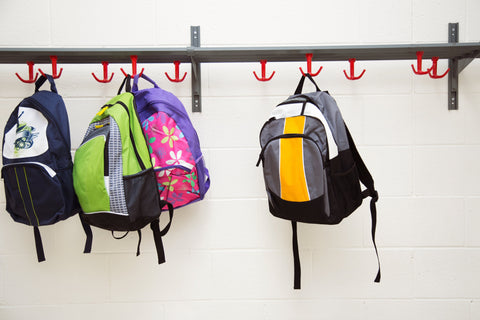Back when I was in school, school books were very much a thing. Textbooks were heavy, ugly, and teachers forced us to bring them to class even if we didn’t need them. Now, in the modern world, textbooks are nearly a thing of the past thanks to ebooks and the cloud. Kids will never know the pain and agony of carrying around boulders on your back all day long.
The only relief from being forced to work on your back muscles all day is having a backpack that could stand up to the abuse of holding books, binders, library books, and endless school supplies.
A great backpack can be a lifesaver for kids. Taking the time to pick the right one can be the difference between buying a bag that lasts until winter break or until the end of the school year. Not only that, it can make a big difference in the quality of life for your student if they’re the type to be carrying a ton on their shoulders all day long.
Bags of All Types
As my adult spine reminds me every morning when I get up, not all backpacks are created equal. There are different types of backpacks depending on what type of function it needs to serve. The most common types to choose from include:
- Outdoor Backpacks - These packs are often built for more rugged use as the name would suggest. Outdoor backpacks have adjustable straps for comfort and a ton of compartments for storage.
- Academic Backpacks - As the name suggests, these are made for school. They’ll often have padded straps, which makes them gentle on the shoulder and the newer versions will have a separate compartment for a laptop or tablet.
- Athletic Backpacks - Sporty bags like these will have a bit more space for athletes to store their equipment or other items they need.
- Mesh Backpacks - These bags offer just as much storage as academic backpacks, but are made of a fabric woven into a tight net. Some schools require these types of bags as items are easily visible through the mesh.
While outdoor backpacks have a bit more options in terms of storage space, it may be a bit too much for school. Most kids will not thirty or fourty different pockets to store things.
Academic or athletic backpacks are likely a far better option and your student can choose which they prefer based on their needs. Of course, if your school has requirements on backpacks, mesh or clear backpacks might be the only option.
Things to Look for in a Quality Backpack
When you’re out shopping for a new bag, it’s important to pay to the quality of the bag itself before making a final decision. Take the time to open up the bag and examine it all over, inside and out. Some of the things to look for include:
- Loose or bad stitching anywhere on the bag. A few bad stitches can mean the bag will eventually come undone at some point very soon after buying it.
- Frayed edges or issues with the fabric that look like the bag will easily tear or unravel with regular use.
- Bags with exposed zippers should be avoided. Instead, look for bags that have fabric covering up the zipper that keep them safe from the elements.
Essentially, look for any obvious issues that would prevent you from buying something that’s subpar in terms of quality. If it looks like it was poorly made, chances are you'll be replacing the bag long before the school year is over. Just remember: if you buy cheap, you’ll get cheap.
Key Requirements for Every Backpack Buyer
Just because a backpack is good quality, doesn’t mean it suitable for everyone. A bag should always be comfortable for whomever is going to be using it. If it’s going to get used frequently throughout the day and isn’t just for casual trips, there are special items to consider to make the quality of life for your student better.
- Take a look at the shoulder straps of the bag. Make sure the straps are wide and have good padding since they’ll be on the shoulders for quite some time during the day.
- Check to see if the bag comes with waist straps or chest straps and make sure they fit your child securely without being too tight.
- Examine the amount of storage space available in the bag and all the available pockets. I’m big on bags having a place for just about everything. Try to find an academic backpack or athletic bag that allows you to store big and small things like folders, books, writing utensils, even electronic devices like tablet or phone, and perhaps even a water bottle.
- The bag should also be proportionate to your child. Don’t buy your son or daughter a backpack that was clearly made for an adult. The bag should be appropriate for their size and sit just below their shoulders when they wear it.
- If possible, bring a few things to put into the bag so your child can test it out before they buy it. Since they’ll be the one wearing it all day, it’s important they try it on.
- Of course, take into consideration your child’s style. Do your best to find a bag they not only like but is functional for their needs. Many kids will want the themed backpacks with superheroes or cartoon characters and won’t care much when it comes to practicality. But, if you can manage to merge the two, you’ll be the super hero.
There is also an important point that every parent should remember outside of function or style: never place too much weight on a child's back. A heavy backpack can lead to future back pain and spine issues if not avoided. Your child should have everything they need for the school day without the danger of overloading their spine by letting them carry heavy books or equipment. If they don't absolutely need something in their backpack, take it out.
A good rule of thumb to follow is to make sure a backpack never weighs more than 10% to 20% of a child’s weight, according to Stutter Health. To make the math easy, take your child’s weight and multiply by .15 to get a middle weight or .2 to get the maximum weight. For instance, if your child weighs 100 pounds, the middle weight would be 15 lbs (100 x .15). While that might not seem like a lot of weight to you as a grown adult, 20 lbs on the back of a child that only weighs 100 lbs is pretty heavy.
Even with all this in mind, don’t spend an arm and a leg shopping for a backpack. Always look for the best deals and never be afraid to shop at second hand stores or even garage sales for slightly used backpacks if you’re trying to save a few pennies. And of course, since School Supply Boxes has revolutionized the way parents and teachers buy school supplies, you’ll be able to spend more time looking for that great backpack for your son or daughter.




Comments (0)
There are no comments for this article. Be the first one to leave a message!